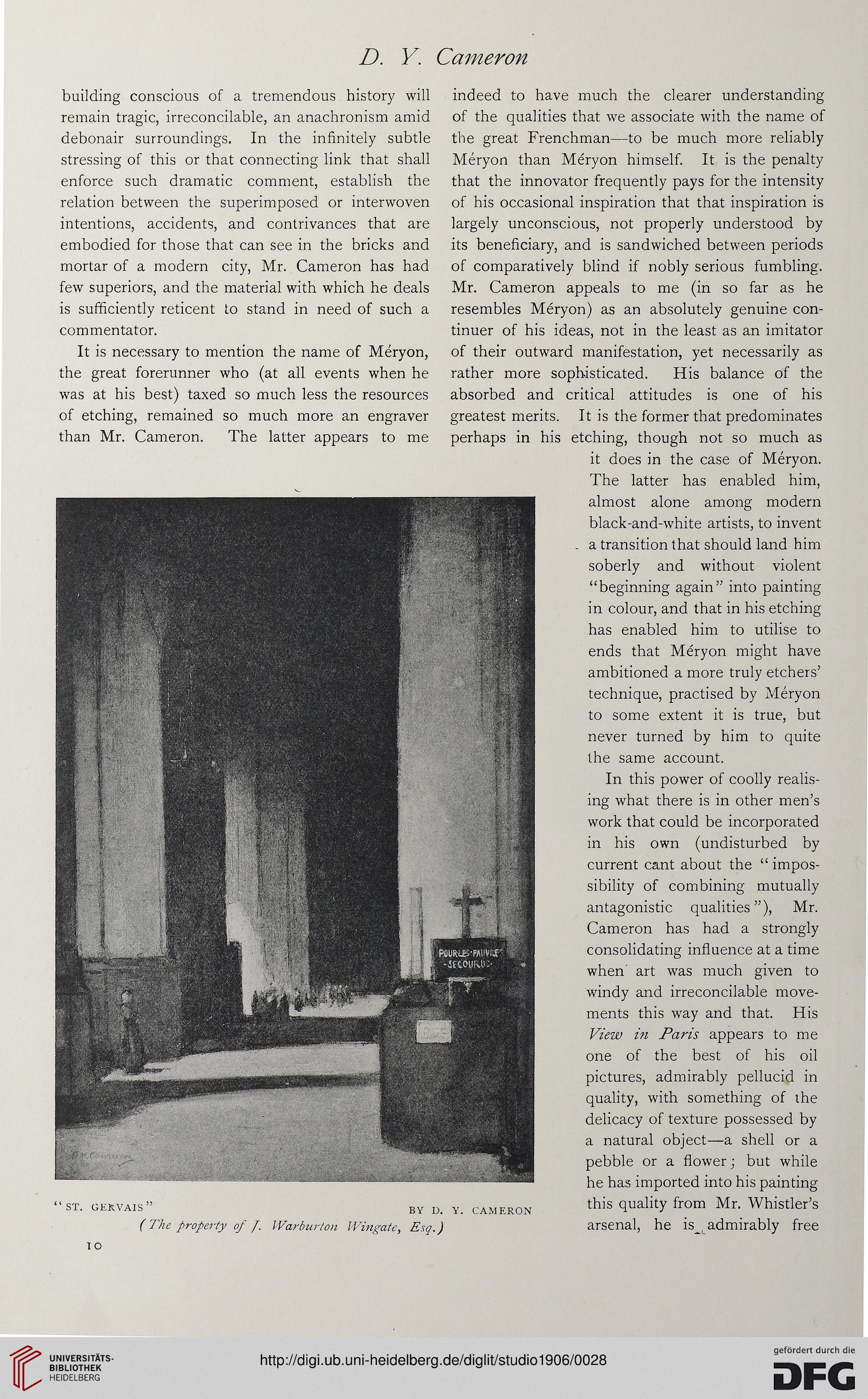D. V. Cameron
building conscious of a tremendous history will
remain tragic, irreconcilable, an anachronism amid
debonair surroundings. In the infinitely subtle
stressing of this or that connecting link that shall
enforce such dramatic comment, establish the
relation between the superimposed or interwoven
intentions, accidents, and contrivances that are
embodied for those that can see in the bricks and
mortar of a modern city, Mr. Cameron has had
few superiors, and the material with which he deals
is sufficiently reticent to stand in need of such a
commentator.
It is necessary to mention the name of Meryon,
the great forerunner who (at all events when he
was at his best) taxed so much less the resources
of etching, remained so much more an engraver
than Mr. Cameron. The latter appears to me
“ST. GERVAIS’
(The property of /. Warburton Wingate, Esq.)
indeed to have much the clearer understanding
of the qualities that we associate with the name of
the great Frenchman—to be much more reliably
Meryon than Meryon himself. It is the penalty
that the innovator frequently pays for the intensity
of his occasional inspiration that that inspiration is
largely unconscious, not properly understood by
its beneficiary, and is sandwiched between periods
of comparatively blind if nobly serious fumbling.
Mr. Cameron appeals to me (in so far as he
resembles Meryon) as an absolutely genuine con-
tinuer of his ideas, not in the least as an imitator
of their outward manifestation, yet necessarily as
rather more sophisticated. His balance of the
absorbed and critical attitudes is one of his
greatest merits. It is the former that predominates
perhaps in his etching, though not so much as
it does in the case of Meryon.
The latter has enabled him,
almost alone among modern
black-and-white artists, to invent
. a transition that should land him
soberly and without violent
“beginning again” into painting
in colour, and that in his etching
has enabled him to utilise to
ends that Meryon might have
ambitioned a more truly etchers’
technique, practised by Meryon
to some extent it is true, but
never turned by him to quite
the same account.
In this power of coolly realis-
ing what there is in other men’s
work that could be incorporated
in his own (undisturbed by
current cant about the “ impos-
sibility of combining mutually
antagonistic qualities”), Mr.
Cameron has had a strongly
consolidating influence at a time
when art was much given to
windy and irreconcilable move-
ments this way and that. His
View in Paris appears to me
one of the best of his oil
pictures, admirably pellucid in
quality, with something of the
delicacy of texture possessed by
a natural object—a shell or a
pebble or a flower; but while
he has imported into his painting
this quality from Mr. Whistler’s
arsenal, he is^ admirably free
BY D. Y. CAMERON
building conscious of a tremendous history will
remain tragic, irreconcilable, an anachronism amid
debonair surroundings. In the infinitely subtle
stressing of this or that connecting link that shall
enforce such dramatic comment, establish the
relation between the superimposed or interwoven
intentions, accidents, and contrivances that are
embodied for those that can see in the bricks and
mortar of a modern city, Mr. Cameron has had
few superiors, and the material with which he deals
is sufficiently reticent to stand in need of such a
commentator.
It is necessary to mention the name of Meryon,
the great forerunner who (at all events when he
was at his best) taxed so much less the resources
of etching, remained so much more an engraver
than Mr. Cameron. The latter appears to me
“ST. GERVAIS’
(The property of /. Warburton Wingate, Esq.)
indeed to have much the clearer understanding
of the qualities that we associate with the name of
the great Frenchman—to be much more reliably
Meryon than Meryon himself. It is the penalty
that the innovator frequently pays for the intensity
of his occasional inspiration that that inspiration is
largely unconscious, not properly understood by
its beneficiary, and is sandwiched between periods
of comparatively blind if nobly serious fumbling.
Mr. Cameron appeals to me (in so far as he
resembles Meryon) as an absolutely genuine con-
tinuer of his ideas, not in the least as an imitator
of their outward manifestation, yet necessarily as
rather more sophisticated. His balance of the
absorbed and critical attitudes is one of his
greatest merits. It is the former that predominates
perhaps in his etching, though not so much as
it does in the case of Meryon.
The latter has enabled him,
almost alone among modern
black-and-white artists, to invent
. a transition that should land him
soberly and without violent
“beginning again” into painting
in colour, and that in his etching
has enabled him to utilise to
ends that Meryon might have
ambitioned a more truly etchers’
technique, practised by Meryon
to some extent it is true, but
never turned by him to quite
the same account.
In this power of coolly realis-
ing what there is in other men’s
work that could be incorporated
in his own (undisturbed by
current cant about the “ impos-
sibility of combining mutually
antagonistic qualities”), Mr.
Cameron has had a strongly
consolidating influence at a time
when art was much given to
windy and irreconcilable move-
ments this way and that. His
View in Paris appears to me
one of the best of his oil
pictures, admirably pellucid in
quality, with something of the
delicacy of texture possessed by
a natural object—a shell or a
pebble or a flower; but while
he has imported into his painting
this quality from Mr. Whistler’s
arsenal, he is^ admirably free
BY D. Y. CAMERON




